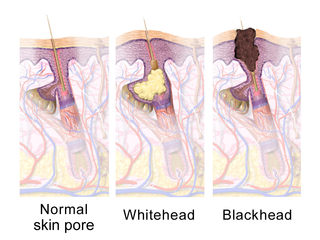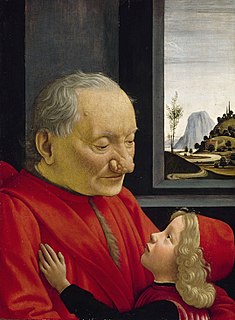 W
WNeonatal acne, often called neonatal cephalic pustulosis, is an acneiform eruption that occurs in newborns or infants, and is often seen on the nose and adjacent portions of the cheeks.
 W
WHidradenitis suppurativa (HS), also known as acne inversa, is a long-term auto-inflammatory disease characterized by the occurrence of inflamed and swollen lumps. These are typically painful and break open, releasing fluid or pus. The areas most commonly affected are the underarms, under the breasts, and the groin. Scar tissue remains after healing.
 W
WAcne keloidalis nuchae is a destructive scarring folliculitis that occurs almost exclusively on the occipital scalp of people of African descent, primarily men.
 W
WAcne keloidalis nuchae is a destructive scarring folliculitis that occurs almost exclusively on the occipital scalp of people of African descent, primarily men.
 W
WNeonatal acne, often called neonatal cephalic pustulosis, is an acneiform eruption that occurs in newborns or infants, and is often seen on the nose and adjacent portions of the cheeks.
 W
WRosacea is a long-term skin condition that typically affects the face. It results in redness, pimples, swelling, and small and superficial dilated blood vessels. Often, the nose, cheeks, forehead, and chin are most involved. A red, enlarged nose may occur in severe disease, a condition known as rhinophyma.
 W
WAcne, also known as acne vulgaris, is a long-term skin disease that occurs when dead skin cells and oil from the skin clog hair follicles. Typical features of the condition include blackheads or whiteheads, pimples, oily skin, and possible scarring. It primarily affects skin with a relatively high number of oil glands, including the face, upper part of the chest, and back. The resulting appearance can lead to anxiety, reduced self-esteem, and, in extreme cases, depression or thoughts of suicide.
 W
WChloracne is an acne-like eruption of blackheads, cysts, and pustules associated with exposure to certain halogenated aromatic compounds, such as chlorinated dioxins and dibenzofurans. The lesions are most frequently found on the cheeks, behind the ears, in the armpits and groin region.
 W
WA comedo is a clogged hair follicle (pore) in the skin. Keratin combines with oil to block the follicle. A comedo can be open (blackhead) or closed by skin (whitehead) and occur with or without acne. The word comedo comes from the Latin comedere, meaning 'to eat up', and was historically used to describe parasitic worms; in modern medical terminology, it is used to suggest the worm-like appearance of the expressed material.
 W
WAcne keloidalis nuchae is a destructive scarring folliculitis that occurs almost exclusively on the occipital scalp of people of African descent, primarily men.
 W
WRosacea is a long-term skin condition that typically affects the face. It results in redness, pimples, swelling, and small and superficial dilated blood vessels. Often, the nose, cheeks, forehead, and chin are most involved. A red, enlarged nose may occur in severe disease, a condition known as rhinophyma.
 W
WFeline acne is a problem seen in cats primarily involving the formation of blackheads accompanied by inflammation on the cat's chin and surrounding areas that can cause lesions, alopecia, and crusty sores. In many cases symptoms are mild and the disease does not require treatment. Mild cases will look like dirt on the cat's chin, but the dirt will not brush off. More severe cases, however, may respond slowly to treatment and seriously detract from the health and appearance of the cat. Feline acne can affect cats of any age, sex or breed, although Persian cats are also likely to develop acne on the face and in the skin folds. This problem can happen once, be reoccurring, or even persistent throughout the cat's life.
 W
WAcne keloidalis nuchae is a destructive scarring folliculitis that occurs almost exclusively on the occipital scalp of people of African descent, primarily men.
 W
WAcne keloidalis nuchae is a destructive scarring folliculitis that occurs almost exclusively on the occipital scalp of people of African descent, primarily men.
 W
WRosacea is a long-term skin condition that typically affects the face. It results in redness, pimples, swelling, and small and superficial dilated blood vessels. Often, the nose, cheeks, forehead, and chin are most involved. A red, enlarged nose may occur in severe disease, a condition known as rhinophyma.
 W
WHidradenitis suppurativa (HS), also known as acne inversa, is a long-term auto-inflammatory disease characterized by the occurrence of inflamed and swollen lumps. These are typically painful and break open, releasing fluid or pus. The areas most commonly affected are the underarms, under the breasts, and the groin. Scar tissue remains after healing.
 W
WRosacea is a long-term skin condition that typically affects the face. It results in redness, pimples, swelling, and small and superficial dilated blood vessels. Often, the nose, cheeks, forehead, and chin are most involved. A red, enlarged nose may occur in severe disease, a condition known as rhinophyma.
 W
WLupus miliaris disseminatus faciei , also known as acne agminata, is a disease with a similar appearance to acne vulgaris. The cause of LMDF is unknown.
 W
WRosacea is a long-term skin condition that typically affects the face. It results in redness, pimples, swelling, and small and superficial dilated blood vessels. Often, the nose, cheeks, forehead, and chin are most involved. A red, enlarged nose may occur in severe disease, a condition known as rhinophyma.
 W
WNeonatal acne, often called neonatal cephalic pustulosis, is an acneiform eruption that occurs in newborns or infants, and is often seen on the nose and adjacent portions of the cheeks.
 W
WNeonatal acne, often called neonatal cephalic pustulosis, is an acneiform eruption that occurs in newborns or infants, and is often seen on the nose and adjacent portions of the cheeks.
 W
WAcne keloidalis nuchae is a destructive scarring folliculitis that occurs almost exclusively on the occipital scalp of people of African descent, primarily men.
 W
WPAPA syndrome is an acronym for pyogenic arthritis, pyoderma gangrenosum and acne. It is a rare genetic disorder characterised by its effects on skin and joints.
 W
WPeriorbital dermatitis is a skin condition, a variant of perioral dermatitis, occurring on the lower eyelids and skin adjacent to the upper and lower eyelids.
 W
WPerioral dermatitis, also known as periorificial dermatitis, is a common type of skin rash. Symptoms include multiple small (1–2 mm) bumps and blisters sometimes with background redness and scale, localized to the skin around the mouth and nostrils. Less commonly the eyes and genitalia may be involved. It can be persistent or recurring and resembles particularly rosacea and to some extent acne and allergic dermatitis. The term "dermatitis" is a misnomer because this is not an eczematous process.
 W
WPeriorbital dermatitis is a skin condition, a variant of perioral dermatitis, occurring on the lower eyelids and skin adjacent to the upper and lower eyelids.
 W
WRosacea is a long-term skin condition that typically affects the face. It results in redness, pimples, swelling, and small and superficial dilated blood vessels. Often, the nose, cheeks, forehead, and chin are most involved. A red, enlarged nose may occur in severe disease, a condition known as rhinophyma.
 W
WRosacea is a long-term skin condition that typically affects the face. It results in redness, pimples, swelling, and small and superficial dilated blood vessels. Often, the nose, cheeks, forehead, and chin are most involved. A red, enlarged nose may occur in severe disease, a condition known as rhinophyma.
 W
WHidradenitis suppurativa (HS), also known as acne inversa, is a long-term auto-inflammatory disease characterized by the occurrence of inflamed and swollen lumps. These are typically painful and break open, releasing fluid or pus. The areas most commonly affected are the underarms, under the breasts, and the groin. Scar tissue remains after healing.
 W
WRhinophyma is a condition causing development of a large, bulbous nose associated with granulomatous infiltration, commonly due to untreated rosacea.
 W
WRosacea is a long-term skin condition that typically affects the face. It results in redness, pimples, swelling, and small and superficial dilated blood vessels. Often, the nose, cheeks, forehead, and chin are most involved. A red, enlarged nose may occur in severe disease, a condition known as rhinophyma.
 W
WRosacea is a long-term skin condition that typically affects the face. It results in redness, pimples, swelling, and small and superficial dilated blood vessels. Often, the nose, cheeks, forehead, and chin are most involved. A red, enlarged nose may occur in severe disease, a condition known as rhinophyma.
 W
WRosacea is a long-term skin condition that typically affects the face. It results in redness, pimples, swelling, and small and superficial dilated blood vessels. Often, the nose, cheeks, forehead, and chin are most involved. A red, enlarged nose may occur in severe disease, a condition known as rhinophyma.
 W
WRosacea is a long-term skin condition that typically affects the face. It results in redness, pimples, swelling, and small and superficial dilated blood vessels. Often, the nose, cheeks, forehead, and chin are most involved. A red, enlarged nose may occur in severe disease, a condition known as rhinophyma.
 W
WSteroid-induced rosacea is an iatrogenic condition from the use of either systemic steroid or topical steroids. It is nearly identical to steroid induced acne from the standpoint of etiology.
 W
WRosacea is a long-term skin condition that typically affects the face. It results in redness, pimples, swelling, and small and superficial dilated blood vessels. Often, the nose, cheeks, forehead, and chin are most involved. A red, enlarged nose may occur in severe disease, a condition known as rhinophyma.
 W
WHidradenitis suppurativa (HS), also known as acne inversa, is a long-term auto-inflammatory disease characterized by the occurrence of inflamed and swollen lumps. These are typically painful and break open, releasing fluid or pus. The areas most commonly affected are the underarms, under the breasts, and the groin. Scar tissue remains after healing.